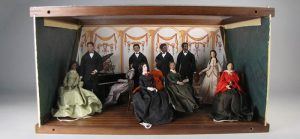Amanda Moniz in Smithsonian:
 The arts are “a space where we can give dignity to others while interrogating our own circumstances,” said Darren Walker, president of the Ford Foundation, at the Smithsonian’s National Museum of American History’s annual symposium, The Power of Giving: Philanthropy’s Impact on American Life. Held this spring, the program explored philanthropy’s impact on and through culture and the arts. As he reflected on the relationship between giving and the arts, Walker said that “throughout our history, we have seen artists and activists work hand in hand. We have seen art inspire and elevate whole movements for change.” As Walker suggests, music, storytelling, drama, and other arts have an emotional impact that motivates giving time and money to causes, while philanthropic appeals help artists attract audiences. To continue the conversation about the arts and giving, here’s a look at three objects that tell stories about how Americans used the arts to promote social change in the 1800s.
The arts are “a space where we can give dignity to others while interrogating our own circumstances,” said Darren Walker, president of the Ford Foundation, at the Smithsonian’s National Museum of American History’s annual symposium, The Power of Giving: Philanthropy’s Impact on American Life. Held this spring, the program explored philanthropy’s impact on and through culture and the arts. As he reflected on the relationship between giving and the arts, Walker said that “throughout our history, we have seen artists and activists work hand in hand. We have seen art inspire and elevate whole movements for change.” As Walker suggests, music, storytelling, drama, and other arts have an emotional impact that motivates giving time and money to causes, while philanthropic appeals help artists attract audiences. To continue the conversation about the arts and giving, here’s a look at three objects that tell stories about how Americans used the arts to promote social change in the 1800s.
In the 1840s, the popular Hutchinson Family Singers from New Hampshire introduced music to the developing antislavery movement. As the sheet music for “The Grave of Bonaparte” suggests, the singers were concerned about freedom in other forms and many places, but they had their biggest impact on the American antislavery movement. Performing before integrated audiences, siblings Judson, John, Asa, and Abby—who were managed by their brother Jesse—helped nurture opposition to slavery among those not exposed to its evils. They also helped build far-flung antislavery networks thanks to their travel and the newspaper coverage of their events. Moreover, the success of their antislavery songs showed that the cause had commercial appeal. Works such as the novel Uncle Tom’s Cabin would cater to that appeal–and help further develop antislavery sentiment. In addition to their contributions to reform causes, the group shaped American musical identity. At a time when Americans favored European musicians, the Hutchinson Family Singers spurred new interest in American music.
More here.
